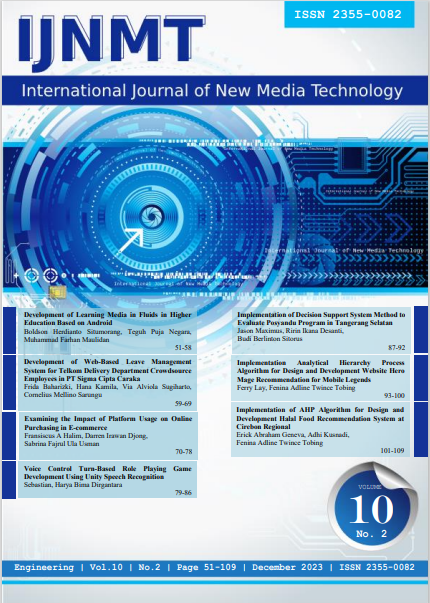A Development of Learning Media in Fluids in Higher Education Based on Android
DOI:
https://doi.org/10.31937/ijnmt.v10i2.3007Abstract
The impact of the corona virus pandemic has disrupted all activities in Indonesia, especially in teaching and learning activities in universities. The lecture process has changed, such as the ban on face-to-face meetings, which has an impact on the learning system on campus. Therefore, the government has implemented an online learning system to overcome the massive spread of the virus while maintaining lectures. One of the issues at issue is practicum activities which require students to come directly to the laboratory, so a solution is needed, namely learning media that can support distance learning to remain effective. The learning media in this study used the Multimedia Development Life Cycle (MDLC) method using Frame by Frame, Low-poly modeling and Shader Graph techniques. The results of this study are an Android-based fluid case learning medium, where, in the application, users can try simulations in the form of 3D animations and work on practice questions and post-tests. Thus, users can better understand fluid materials without the need to do practical work in a physics laboratory.
Downloads
Additional Files
Published
How to Cite
Issue
Section
License
Authors retain copyright and grant the journal right of first publication with the work simultaneously licensed under a Creative Commons Attribution-ShareAlike International License (CC-BY-SA 4.0) that allows others to share the work with an acknowledgement of the work's authorship and initial publication in this journal.
Authors are able to enter into separate, additional contractual arrangements for the non-exclusive distribution of the journal's published version of the work (e.g., post it to an institutional repository or publish it in a book), with an acknowledgement of its initial publication in this journal.
Copyright without Restrictions
The journal allows the author(s) to hold the copyright without restrictions and will retain publishing rights without restrictions.
The submitted papers are assumed to contain no proprietary material unprotected by patent or patent application; responsibility for technical content and for protection of proprietary material rests solely with the author(s) and their organizations and is not the responsibility of the IJNMT or its Editorial Staff. The main (first/corresponding) author is responsible for ensuring that the article has been seen and approved by all the other authors. It is the responsibility of the author to obtain all necessary copyright release permissions for the use of any copyrighted materials in the manuscript prior to the submission.















